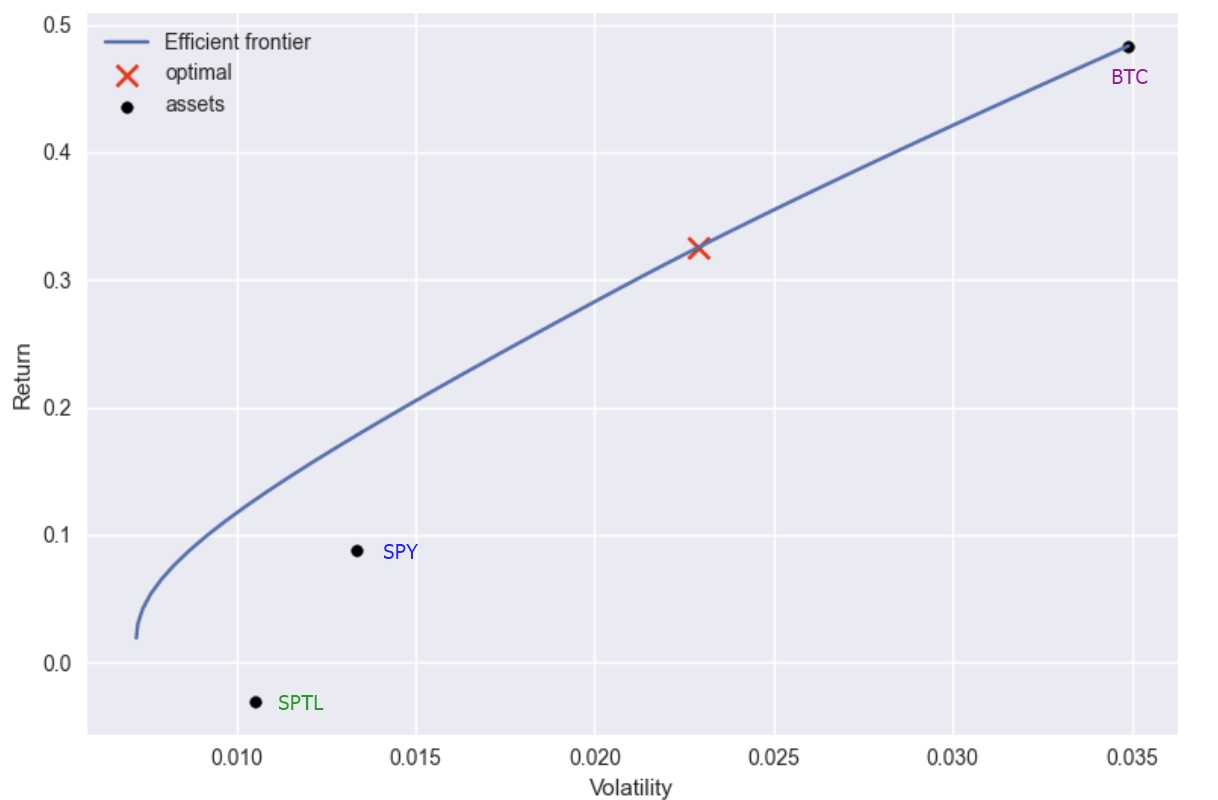
What’s the ideal mix of traditional investments and crypto investments?
While bitcoin and other crypto investments offer the potential for outsized returns, they also hold outsized risk. At Bitcoin Market Journal, we aim for a balanced investment strategy that minimizes risks as much as possible.
To help us find the ideal portfolio, we turn to Modern Portfolio Theory (MPT).
MPT is about achieving the optimal balance between risk and reward through diversification. Rather than going “all in” on bitcoin, we balance the wild fluctuations of crypto with more traditional investments. MPT helps us find the right mix.
In this article, we’ll explore two types of investor personas: the balanced investor and the crypto bro. Who’s the winner? Spoiler: it’s the one who’s using the MPT approach.
What Is Modern Portfolio Theory?
In a nutshell, MPT suggests that diversification is the key to maximizing returns while minimizing risks.
You can think of it as preparing for a long trip where you should be ready for all kinds of weather. You would pack an umbrella, sunscreen, and a warm jacket.
Similarly, diversifying your investment portfolio using the MPT strategy means preparing for various economic “climates,” from hot crypto bull runs to frigid crypto winters.
By allocating across different asset classes, you can leverage the returns of volatile assets like bitcoin, while protecting against an expected market downturn.
Who Created MPT?
Modern portfolio theory was introduced by the American economist Harry Markowitz in 1952 in a paper titled “Portfolio Selection.” Markowitz later received the Nobel Prize for his work on this investment approach.
He called for a diversified portfolio that would give exposure to different asset classes, such as company stocks, bonds, real estate, commodities, and hedge funds.
If he knew about crypto, he’d probably allocate some portion of a diversified portfolio to this new asset class. That’s because crypto’s low correlation to traditional investments helps reduce risk.
Take, for example, BTC’s correlation with the S&P 500 index, the NASDAQ index, and gold:

In the chart above, we see that the S&P and NASDAQ are highly correlated, so they offer little diversification. Gold, however, is not correlated with stocks so it can serve as protection: when stocks go down, gold may go up (and vice versa).
Markowitz argued that the diversification methods could vary. For example, a portfolio may rely on asset allocation models, sector allocation models, industry allocation models, or geographic allocation models.
The main goal of MPT is to maximize returns while mitigating risks.
Many mutual funds in the US follow the MPT guidelines to maximize the performance of their portfolios.
Our vision of a balanced portfolio with a small amount allocated to crypto is based on modern portfolio theory.
Modern Portfolio Theory in Action
Let’s explore two sample investors and see who wins in the long term:
The Balanced Investor
Imagine Alice, the balanced investor. She is an experienced captain navigating calm, stormy seas with a well-equipped ship.
For example, she uses our “Blockchain Believers” portfolio strategy, which allocates to traditional stocks (65%), bonds (32.5%), and a tiny slice of bitcoin (2.5%).
This mix enables her to leverage the potential growth of digital currencies while anchoring her portfolio with the stability of traditional assets.
This approach has many benefits, like:
- Stability amid the crypto market’s high volatility and turbulence.
- Smoothing out the portfolio’s volatility.
- Focus on long-term growth.
The Crypto Bro
On the other side, we have Bob, the crypto bro speculating on the price of crypto assets, trying to find the next big coin. While his portfolio is diverse, it carries a lot of risky assets–Almost a third is dedicated to memecoins like DOGE, Shibu Inu, dogwifhat. So, while the assets are varied, the risk isn’t, and other than the large chunk of ETH their isn’t much to absorb volatility.
In the best-case scenario, his portfolio allocates the lion’s share to Ethereum. However, many crypto investors chase rapid gains, betting on riskier crypto assets, such as meme coins, which have no utility and fundamentals to back them.
Who Wins in the Long Term?
Alice’s diversified portfolio experiences lower volatility. The stability of traditional investments offsets her losses during crypto market downturns. Meanwhile, her crypto exposure provides substantial upside during market recovery and bull runs.
On the other side, Bob faces a rollercoaster ride. His portfolio’s value surged during the crypto market boom but eventually plummeted during the bust cycle, erasing previous gains. This illustrates that better long-term strategies may exist than putting all eggs in a single basket like crypto.
Applying MPT to Crypto Investments
The crypto market has provided tremendous opportunities for early investors who stuck to “hodling” rather than speculating.
For example, bitcoin has gained over 10,000% during the last decade.
However, it has gone through wild price fluctuations, and most investors have been tempted to sell to either take profits or exit during multi-month bearish trends. It’s not easy to be a hodler.
In contrast, traditional markets have also increased in value but have been much more stable and balanced. The S&P 500 index (SPY) has risen by over 150% during the same period.
Fixed-income investments, such as government bonds, have mostly provided negative yields during the last decade, but they still offer stability to a diversified portfolio. For instance, SPDR Portfolio Long Term Treasury ETF (SPTL) has declined 15% for the same period but doesn’t show extreme volatility.
We think the best approach for risk-averse investors is to consider the MPT principles and build a diversified portfolio exposed to crypto assets. Our preferred approach:
- Roughly 2/3 into a stock index ETF
- Roughly 1/3 into a bond index ETF
- Just a slice (between 2-10%) into bitcoin or crypto assets.
This mix seeks to capitalize on the stock market’s growth, the safety of bonds, and bitcoin’s explosive potential.
Modern Portfolio Theory and the Baby Believers Portfolio
We tested a version of our own Baby Believers Portfolio as an experiment. We used data from the past five years for SPY (stocks), SPTL (bonds), and BTC (bitcoin) to find the “optimal” portfolio, using the MPT formula for balancing risk and return.

In the “optimal allocation” (shown by the red X), we have:
- Expected annual return: 32.6%
- Annual volatility: 2.3%
- Sharpe Ratio: 13.34
By any measure, an annual return of 32.6% is stellar, particularly when only exposing yourself to 2.3% annual volatility in the portfolio. It’s a very good risk/reward ratio, as borne out by the relatively high Sharpe Ratio—generally, the higher the Sharpe ratio, the more attractive the risk-adjusted return.
However, let’s look at the portfolio allocation recommended by this MPT model:
- BTC: 72.5% of portfolio
- SPY: 27.5% of portfolio
- SPTL: 0.0% of portfolio
This is much different from our standard approach, with almost three-quarters allocated to crypto! However, the annual volatility of this very BTC-heavy portfolio would have remained reasonable.
Remember: this is a backward-looking model based on historical performance, and past performance does not indicate future results.
Most investors simply don’t have the conviction to put 75% of their savings into bitcoin, which is why our Blockchain Believers models present an alternative to help you sleep better at night.
Investor’s Takeaway
Modern portfolio theory is a strategy that works with various asset classes, especially for long-term investments. It highlights the power of diversification in reaching an optimal balance between risk and reward.
While the “optimal” portfolio over the past five years might have been 75% bitcoin and 25% stocks, we stick to our more conservative investing strategy of just a tiny slice into crypto assets, which still beats the traditional investor by far.
Subscribe to the Bitcoin Market Journal newsletter to get regular updates on the performance of our Blockchain Believers portfolio.
- SEO Powered Content & PR Distribution. Get Amplified Today.
- PlatoData.Network Vertical Generative Ai. Empower Yourself. Access Here.
- PlatoAiStream. Web3 Intelligence. Knowledge Amplified. Access Here.
- PlatoESG. Carbon, CleanTech, Energy, Environment, Solar, Waste Management. Access Here.
- PlatoHealth. Biotech and Clinical Trials Intelligence. Access Here.
- Source: https://www.bitcoinmarketjournal.com/modern-portfolio-theory/



